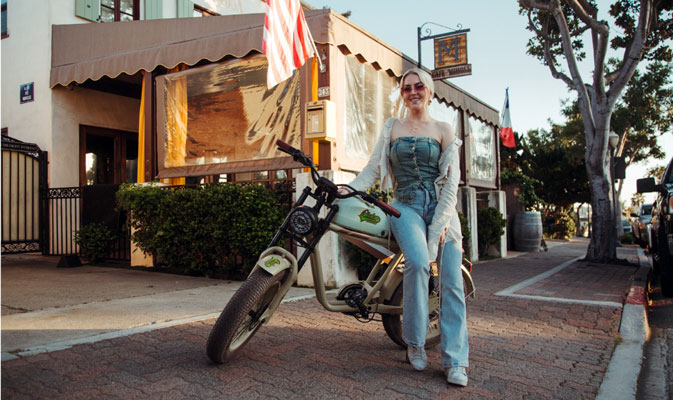Retro Electric Bikes bring café racer style to everyday riding with modern power. They’re comfy, have plenty of character, and actually get stuff done. They’re easy to hop on, easy to look after, and perfect for errands or a spin just for fun. If the vibe of a vintage moped appeals without the noise or gas, you’ll feel right at home. In this guide, we’ll cover what they are, why they’re popular, how to pick and set one up, and how to keep it running smoothly.
Why Retro Electric Bikes are back with modern riders
A Retro Electric Bike hits a sweet mix of style and practicality. Picture a bench seat, upright posture, round headlight, and a calm ride with real punch. In the city, you get easy speed without stress, and on rough pavement, fat tires keep things steady. Most models take racks, bags, and child seats, so they pull double duty for daily transport. In neighborhoods where a car feels like too much, a Retro Electric Bike becomes the fun utility vehicle that still earns nods at every stoplight.
What “retro” means in practice
Retro is more than paint. The geometry is relaxed, the bars are wide, and the long saddle lets you shift around on longer rides. Many use 20×4.0-inch tires that float over potholes and curbs, which helps new riders and urban commuters. You get the old moped vibe without clutching, shifting, or fumes. Under the skin, it is thoroughly modern: hydraulic disc brakes, color displays, multiple assist levels, and removable lithium batteries. If you want comfort, predictable handling, and personality, this layout delivers.
Real world example: Qiolor TIGER RE
Qiolor’s TIGER RE line shows how classic looks and current tech fit together. The retro frame pairs with a 750 W rear hub that peaks around 1100 W and delivers up to 85 Nm of torque, which covers city hills in the 10 to 15 percent range with a moderate load. Many builds ship with dual-piston hydraulic brakes for strong, quiet stops. Depending on battery choice, 48 V 15 Ah or 48 V 35 Ah, the claimed top speed sits in the mid 20s mph, and range runs about 60 to 130 miles with pedal assist. Fat 20×4.0 tires and a rated max load near 400 lb make it friendly for bigger riders or those hauling gear.
Table: Qiolor TIGER RE at a Glance
| Feature | Typical TIGER RE spec | Why it matters |
| Motor & peak | 750 W (peaks ~1100 W) | Punchy launches; confident on short, steep streets. |
| Max torque | ~85 Nm | ≥ 80 Nm helps on 10% hills with a 180–200 lb rider. |
| Battery options | 48 V 15 Ah / 35 Ah | Choose lighter commuter setup or long-range touring. |
| Brakes | Dual-piston hydraulic | Strong, low-effort stopping in rain or dry. |
| Tires | 20×4.0 fat tires | Stable, forgiving, “cushion” feel on bad pavement. |
| Load rating | Up to ~400 lb | Room for racks, bags, and heavier riders. |
Set up that feels right on day one (fit, safety, city tuning)
Start simple so the ride matches the vibe: calm and confident.
- Saddle height: With the crank at 6 o’clock, aim for a soft knee bend of about 25–30°. Too low can ache your knees; too high can hurt your balance at stops.
- Bar angle: Keep wrists straight and shoulders relaxed. Rotate the bar until your elbows hang naturally.
- Tire pressure: On 20×4.0 tires, start at 18–22 PSI for comfort under a 200 lb total load. Go 22–28 PSI with cargo to stop squirm.
- Brake feel: Levers should bite in the first third of travel. Bed pads with 10–15 controlled stops from 15 mph.
- Assist levels: Run PAS 1–2 for paths, PAS 3–4 for traffic merges, and use throttle only for tight starts.
- Lighting and horn: A bright 160-lux headlight plus an active brake/turn tail light make evening rides calmer. Use them in daylight too.
- Cargo balance: Keep heavy items low and centered on the rear rack to preserve that easy, planted steering.
Maintenance essentials to keep it retro and reliable
Treat it like a favorite daily: quick touch-ups often, deeper care monthly.
- Chain: wipe weekly, lube every 100–150 miles or after rain.
- Tires: check fat-tire PSI before weekend rides; a few PSI changes handling.
- Brakes: inspect hydraulic pads monthly; replace when near 1 mm of friction material is worn.
- Battery: keep terminals clean; charge 20–85% for life. For winter storage, park at ~60% and top up monthly.
- Hardware: quick bolt check on racks, fenders, and the bench seat to stop rattles early.
Troubleshooting & smart upgrades (when you want more)
Rhythmic click while pedaling: check for chainline rub at the chainring guard or a slightly bent derailleur hanger. Minor tweaks fix most noises fast.
- Spongy brakes: re-bed the pads or bleed the lines. Hydraulics should feel firm and progressive.
- Range anxiety: if your model allows, step up to a higher-capacity pack. 35 Ah options on bikes like the TIGER can push assist range past 100 miles at sensible speeds.
- Sharper handling: swap to quality 20×4.0 street tread and set PSI to match your payload; most riders feel a big improvement under 25 mph.
- Power feel: stay within local Class rules. A controller tune for smoother ramp-up often rides better than chasing top speed.
Conclusion
If you want classic style without giving up everyday comfort, a Retro Electric Bike is a smart pick—especially a fat tire electric bike like the Qiolor TIGER RE. Those wide 20×4.0 tires calm rough streets, the upright posture keeps your back happy, and modern brakes and batteries make city rides simple. Keep tire pressure dialed, lube the chain on schedule, and charge between 20% and 85% to stretch battery life. Whether you’re commuting, grabbing groceries, or cruising with friends, you’ll get the vintage vibe with real utility. Ready to roll? Choose the range and accessories that fit your week and make the look your own.









